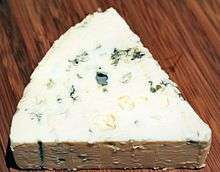Danish Blue Cheese
Danablu, often marketed under the trademark Danish Blue Cheese within North America,[1] is a strong, blue-veined cheese.[2] This semi-soft creamery cheese is typically drum- or block-shaped and has a white-to-yellowish, slightly moist, edible rind. Made from full fat cow's milk and homogenised cream, it has a fat content of 25–30% (50–60% in dry matter) and is aged for eight to twelve weeks.[1]
| Danablu | |
|---|---|
 | |
| Other names | Danish Blue |
| Country of origin | Denmark |
| Source of milk | Cows |
| Texture | Semi-soft |
| Aging time | 8–12 weeks |
| Certification | Danablu: PGI |
Before ageing, copper wires or rods are used to pierce the formed curds to distribute the mould (Penicillium roqueforti) evenly through the cheese. The holes can still be seen when the finished wheel is cut open.
Danablu was invented early in the 20th century by a Danish cheese maker named Marius Boel with the intention of emulating a Roquefort-style cheese. Danablu has a milder flavour characterised by a sharp, salty taste, and is often served crumbled on salads or as a dessert cheese with fruit. In Denmark, it is often served on bread or savoury biscuits crackers.
Danablu, Danbo and Esrom are the only three Danish cheeses that are PGI-marked by the EU,[3] meaning that they may be produced only in Denmark from Danish milk and at approved dairies that produce the cheeses according to the specifications laid down.
See also
References
- "Council Regulation (EC) No 510/2006 Amendment Application According to Article 9 'Danablu' EC No: DK-PGI-0217-0328-21.02.2011" (PDF). Official Journal of the European Union. Retrieved December 22, 2014.
- "Archived copy". Archived from the original on 2014-08-25. Retrieved 2014-10-19.CS1 maint: archived copy as title (link)
- http://www.danablu.dk/esrom.aspx